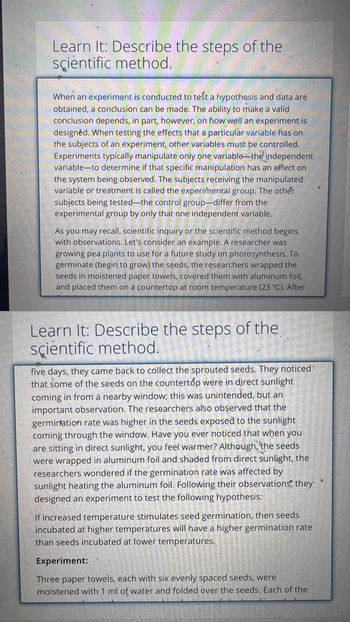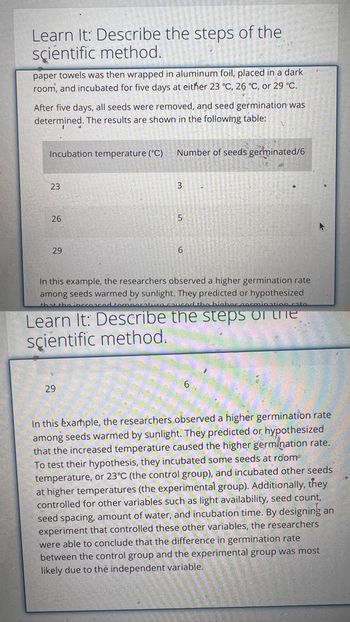
Human Anatomy & Physiology (11th Edition)
11th Edition
ISBN: 9780134580999
Author: Elaine N. Marieb, Katja N. Hoehn
Publisher: PEARSON
expand_more
expand_more
format_list_bulleted
Concept explainers
Question
Which of the following conditions were kept the same between the control group and the experimental group? Select all that apply.
Incubation time
Temperature
Seed spacing
Light availability
Water availability

Transcribed Image Text:Learn It: Describe the steps of the
scientific method.
When an experiment is conducted to test a hypothesis and data are
obtained, a conclusion can be made. The ability to make a valid
conclusion depends, in part, however, on how well an experiment is
designed. When testing the effects that a particular variable has on
the subjects of an experiment, other variables must be controlled.
Experiments typically manipulate only one variable the independent
variable to determine if that specific manipulation has an effect on
the system being observed. The subjects receiving the manipulated
variable or treatment is called the experimental group. The other
subjects being tested-the control group-differ from the
experimental group by only that one independent variable.
As you may recall, scientific inquiry or the scientific method begins
with observations. Let's consider an example. A researcher was
growing pea plants to use for a future study on photosynthesis. To
germinate (begin to grow) the seeds, the researchers wrapped the
seeds in moistened paper towels, covered them with aluminum foil,
and placed them on a countertop at room temperature (23 °C). After
Learn It: Describe the steps of the
scientific method.
five days, they came back to collect the sprouted seeds. They noticed
that some of the seeds on the countertop were in direct sunlight
coming in from a nearby window; this was unintended, but an
important observation. The researchers also observed that the
germination rate was higher in the seeds exposed to the sunlight
coming through the window. Have you ever noticed that when you
are sitting in direct sunlight, you feel warmer? Although, the seeds
were wrapped in aluminum foil and shaded from direct sunlight, the
researchers wondered if the germination rate was affected by
sunlight heating the aluminum foil. Following their observations, they
designed an experiment to test the following hypothesis:
If increased temperature stimulates seed germination, then seeds
incubated at higher temperatures will have a higher germination rate
than seeds incubated at lower temperatures.
Experiment:
Three paper towels, each with six evenly spaced seeds, were
moistened with 1 ml of water and folded over the seeds. Each of the

Transcribed Image Text:Learn It: Describe the steps of the
scientific method.
paper towels was then wrapped in aluminum foil, placed in a dark
room, and incubated for five days at either 23 °C, 26 °C, or 29 °C.
After five days, all seeds were removed, and seed germination was
determined. The results are shown in the following table:
Incubation temperature (°C) Number of seeds germinated/6
23
26
29
3
29
5
6
In this example, the researchers observed a higher germination rate
among seeds warmed by sunlight. They predicted or hypothesized
that the in
tempera
the higher gormination rato
Learn It: Describe the steps of the
scientific method.
In this example, the researchers observed a higher germination rate
among seeds warmed by sunlight. They predicted or hypothesized
that the increased temperature caused the higher germination rate.
To test their hypothesis, they incubated some seeds at room
temperature, or 23°C (the control group), and incubated other seeds
at higher temperatures (the experimental group). Additionally, they
controlled for other variables such as light availability, seed count,
seed spacing, amount of water, and incubation time. By designing an
experiment that controlled these other variables, the researchers
were able to conclude that the difference in germination rate
between the control group and the experimental group was most
likely due to the independent variable.
Expert Solution
This question has been solved!
Explore an expertly crafted, step-by-step solution for a thorough understanding of key concepts.
This is a popular solution
Trending nowThis is a popular solution!
Step by stepSolved in 3 steps

Knowledge Booster
Learn more about
Need a deep-dive on the concept behind this application? Look no further. Learn more about this topic, biology and related others by exploring similar questions and additional content below.Similar questions
- Following is the data and notice that it is a terrible idea to culture hMSCs longer than 10 days. You’re strongly Days # cells0 50001 75002 125003 125004 218005 287006 530007 1143008 1653009 19200010 19200011 11680012 8950013 8830014 78300 Part1 You are working for a start-up that is pursuing a clinical trial. The trial involves grafting hMSCs intopatients suffering from interveterbral disc disease using a degradable polymer scaffold. You are going to 3Dprint a porous cylindrical scaffold that is 2 cm in radius and 1 cm in height (matching the dimensions of adegenerated disc). Assume a porosity of 50%. You will fill available volume of the scaffold with hMSCs at adensity of 1 million cells per cm3. Based on the data above, what starting number of cells will you use andhow long will it take you to get enough cells for the trial? Part2The trial is a failure (patients did not report any reduction in back pain). Your team wants to try againusing 85% hMSCs and 15% nucleus pulposus cells .…arrow_forwardA scientist is studying the effect a new fertilizer has on the root growth of bean seedlings. Three groups of plants are grown in the same location in a greenhouse, each receiving the same amount of sunlight and water every day. The scientist measures the length of the roots for each plant every day. The scientist then calculates the mean for each group for five days. The results are shown in the following table. Fertilizer Experiment Data Table A What is the independent variable in this experiment? B с Day 1 Day 2 Day 3 Day 4 Day 5 D Group 1 0 mg 3.0 cm 3.2 cm 3.4 cm 3.7 cm 4.2 cm the amount of water given to each plant the amount of fertilizer given to each plant Group 2 5 mg 2.7 cm 3.1 cm 3.7 cm 4.2 cm 4.6 cm the place in the greenhouse where each plant was placed the type of soil used for each plant Group 3 10 mg 2.9 cm 3.3 cm 3.7 cm 3.9 cm 4.1 cmarrow_forwardMina is testing different types of heat lamps to determine which type is most effective for growing strawberry bushes. She purchases two different types of lamps from a local store. Mina applies brand A to one area of the yard and brand B to another area of the yard, both of which receive full sunlight. She waters the area with brand B daily; she waters the area with brand A every other day. At the end of the study, Mina concludes brand B is more effective in growing strawberry bushes. Mina's conclusion valid? Explain why or why not.arrow_forward
- Please send me the question in 20 minutes it's very urgent plzarrow_forwardIs organism 1 a plant animal or neither explain what procedure would you used to perform test A then explain how the results of test A allow you to determine wether the test was positive or negative for organism 1?arrow_forward
arrow_back_ios
arrow_forward_ios
Recommended textbooks for you
 Human Anatomy & Physiology (11th Edition)BiologyISBN:9780134580999Author:Elaine N. Marieb, Katja N. HoehnPublisher:PEARSON
Human Anatomy & Physiology (11th Edition)BiologyISBN:9780134580999Author:Elaine N. Marieb, Katja N. HoehnPublisher:PEARSON Biology 2eBiologyISBN:9781947172517Author:Matthew Douglas, Jung Choi, Mary Ann ClarkPublisher:OpenStax
Biology 2eBiologyISBN:9781947172517Author:Matthew Douglas, Jung Choi, Mary Ann ClarkPublisher:OpenStax Anatomy & PhysiologyBiologyISBN:9781259398629Author:McKinley, Michael P., O'loughlin, Valerie Dean, Bidle, Theresa StouterPublisher:Mcgraw Hill Education,
Anatomy & PhysiologyBiologyISBN:9781259398629Author:McKinley, Michael P., O'loughlin, Valerie Dean, Bidle, Theresa StouterPublisher:Mcgraw Hill Education, Molecular Biology of the Cell (Sixth Edition)BiologyISBN:9780815344322Author:Bruce Alberts, Alexander D. Johnson, Julian Lewis, David Morgan, Martin Raff, Keith Roberts, Peter WalterPublisher:W. W. Norton & Company
Molecular Biology of the Cell (Sixth Edition)BiologyISBN:9780815344322Author:Bruce Alberts, Alexander D. Johnson, Julian Lewis, David Morgan, Martin Raff, Keith Roberts, Peter WalterPublisher:W. W. Norton & Company Laboratory Manual For Human Anatomy & PhysiologyBiologyISBN:9781260159363Author:Martin, Terry R., Prentice-craver, CynthiaPublisher:McGraw-Hill Publishing Co.
Laboratory Manual For Human Anatomy & PhysiologyBiologyISBN:9781260159363Author:Martin, Terry R., Prentice-craver, CynthiaPublisher:McGraw-Hill Publishing Co. Inquiry Into Life (16th Edition)BiologyISBN:9781260231700Author:Sylvia S. Mader, Michael WindelspechtPublisher:McGraw Hill Education
Inquiry Into Life (16th Edition)BiologyISBN:9781260231700Author:Sylvia S. Mader, Michael WindelspechtPublisher:McGraw Hill Education

Human Anatomy & Physiology (11th Edition)
Biology
ISBN:9780134580999
Author:Elaine N. Marieb, Katja N. Hoehn
Publisher:PEARSON

Biology 2e
Biology
ISBN:9781947172517
Author:Matthew Douglas, Jung Choi, Mary Ann Clark
Publisher:OpenStax

Anatomy & Physiology
Biology
ISBN:9781259398629
Author:McKinley, Michael P., O'loughlin, Valerie Dean, Bidle, Theresa Stouter
Publisher:Mcgraw Hill Education,

Molecular Biology of the Cell (Sixth Edition)
Biology
ISBN:9780815344322
Author:Bruce Alberts, Alexander D. Johnson, Julian Lewis, David Morgan, Martin Raff, Keith Roberts, Peter Walter
Publisher:W. W. Norton & Company

Laboratory Manual For Human Anatomy & Physiology
Biology
ISBN:9781260159363
Author:Martin, Terry R., Prentice-craver, Cynthia
Publisher:McGraw-Hill Publishing Co.

Inquiry Into Life (16th Edition)
Biology
ISBN:9781260231700
Author:Sylvia S. Mader, Michael Windelspecht
Publisher:McGraw Hill Education